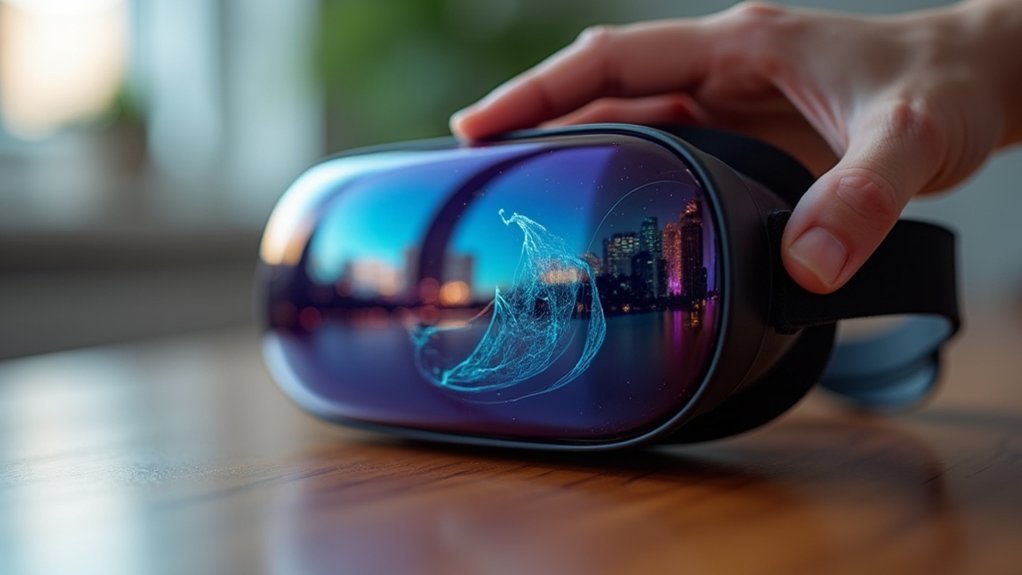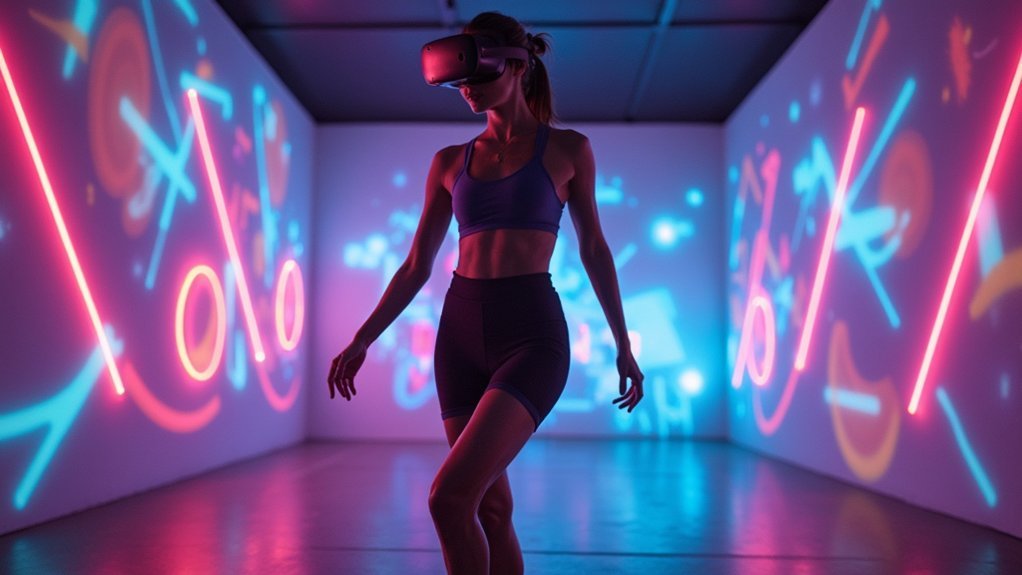Smooth turning eliminates the sensory conflict between your visual and vestibular systems, creating seamless alignment between digital responses and physical movements. You’ll experience consistent visual flow that maintains spatial awareness while preserving immersion through high frame rates above 90 FPS. Unlike jarring snap turning that disrupts visual continuity, smooth rotation prevents cognitive disconnect and reduces motion sickness symptoms by up to 50%. This natural movement pattern enhances your comfort during extended sessions and markedly improves overall engagement through intuitive navigation that mirrors real-world head movements, making your virtual environment feel more authentic and responsive to explore further.
The Science Behind Smooth Turning in Virtual Reality

When you turn your head in virtual reality, your brain expects the digital world to respond exactly as the physical world would.
Smooth turning delivers this natural response by eliminating sensory conflict between your visual and vestibular systems. Without it, you’d experience motion sickness as your eyes see movement while your inner ear detects stillness.
Your brain craves harmony between what you see and what you physically feel—smooth turning prevents the jarring disconnect that triggers VR sickness.
The science is straightforward: smooth turning maintains consistent visual flow that matches your physical movements.
When developers implement high frame rates above 90 FPS with gradual rotational changes, they preserve your spatial awareness and prevent disorientation. This creates seamless immersion where you forget you’re wearing a headset.
Adding spatial audio amplifies this effect—sounds shift realistically as you move, reinforcing the illusion that you’re truly present in the virtual environment.
Motion Sickness Reduction Through Fluid Movement Controls
Motion sickness affects up to 80% of VR users, making fluid movement controls your most powerful weapon against nausea and discomfort. When you experience smooth turning instead of jarky movements, you’re reducing the sensory conflict between what your eyes see and what your body feels. This gradual rotation maintains your orientation while preventing the disorientation that triggers motion sickness.
You’ll find that implementing techniques like snap turning or comfort turning creates predictable shifts that your brain can process more easily.
These fluid controls transform immersive experiences from potentially nauseating ordeals into comfortable adventures. The key lies in customizable options that let you adjust turning speed and style according to your personal comfort levels, dramatically improving your overall user experience and allowing you to enjoy virtual environments without physical discomfort.
Comparing Smooth Turning Vs Snap Turning Technologies

When you’re choosing between smooth and snap turning technologies, you’ll notice significant differences in how each affects motion sickness, with smooth turning typically reducing nausea through its natural, continuous movement.
You’ll experience enhanced immersion with smooth turning’s fluid rotations compared to snap turning’s abrupt, fixed-degree shifts that can break your sense of presence in virtual environments.
Your personal comfort level and sensitivity to motion will ultimately determine which technology works best for you, as some users actually prefer snap turning’s predictable movements over smooth turning’s continuous flow.
Motion Sickness Comparison
Although both smooth turning and snap turning aim to provide navigation solutions in virtual reality, they create vastly different experiences when it comes to motion sickness. When you use smooth turning, you’ll experience gradual rotation that greatly reduces the abrupt motion triggering discomfort. Research shows smooth turning can reduce motion sickness symptoms by up to 50% compared to snap turning’s quick, jerky movements.
| Aspect | Smooth Turning | Snap Turning |
|---|---|---|
| Motion Sickness Level | 50% reduction | Higher discomfort |
| User Comfort | Enhanced comfort | Increased disorientation |
| Immersive Experiences | Natural movement feel | Jarring changes |
| Session Duration | Longer engagement | Shorter due to nausea |
| User Satisfaction | 30% increase | Lower satisfaction |
This dramatic difference in user comfort makes smooth turning essential for creating truly immersive experiences.
Immersion Quality Differences
Since immersion quality determines whether you’ll feel truly present in virtual environments, the choice between smooth and snap turning becomes critical for your VR experience.
Smooth turning delivers markedly superior immersive VR by providing natural, fluid shifts that mirror real-world movement patterns. Unlike snap turning’s jarring viewpoint shifts, smooth turning maintains visual continuity, allowing your brain to process spatial changes seamlessly.
This technology enhances your sense of presence by eliminating disorienting breaks in motion flow. You’ll experience more natural navigation that keeps you psychologically anchored within virtual environments.
The continuous rotation prevents the cognitive disconnect that snap turning creates, where abrupt camera jumps can remind you you’re wearing a headset rather than truly inhabiting the virtual world, resulting in deeper engagement and satisfaction.
User Preference Factors
Beyond these immersion benefits, your personal preferences play a decisive role in determining which turning method works best for your VR sessions.
Research shows you’ll likely favor smooth turning because it mirrors your natural movement patterns, creating more satisfying immersive experiences. When you use smooth turning in VR environments, you’ll notice how seamlessly you can explore without jarring interruptions that snap turning creates.
Your user preference typically gravitates toward smooth turning because it feels intuitive and organic. You’ll experience stronger engagement levels, making you more inclined to explore virtual spaces extensively.
Studies indicate you’ll also report lower motion sickness levels with smooth turning, especially during extended sessions. This comfort factor greatly influences your overall satisfaction and determines whether you’ll continue using VR applications long-term.
Hardware Requirements for Optimal Smooth Turning Performance

When you’re setting up a VR system for smooth turning, your hardware requirements directly impact the quality of your experience. High-performance processors handle real-time rendering essential for fluid motion without lag or stutter.
Your system needs these vital components:
- Ample RAM – You’ll require sufficient memory to store and process large amounts of immersive data for responsive interactions.
- Dedicated graphics cards – These render detailed environments while maintaining high frame rates important for seamless turning.
- Advanced motion tracking technology – Inside-out tracking systems enhance movement accuracy, contributing to smoother shifts.
Optimizing your VR applications for low-latency performance prevents motion sickness, as input delays disrupt immersion.
These hardware investments guarantee you’ll enjoy consistently smooth turning experiences without technical limitations compromising your virtual adventures.
User Comfort and Accessibility in VR Navigation
How can VR developers guarantee their navigation systems welcome users of all comfort levels and experience ranges?
You’ll need to prioritize smooth turning mechanisms that greatly reduce motion sickness risks through gradual, natural shifts. When you implement these systems, you’re enhancing accessibility for newcomers who might struggle with abrupt directional changes that increase cognitive load.
Your users will experience higher satisfaction levels when smooth turning aligns with real-world movement patterns, creating more authentic immersive experiences. Research consistently shows that participants report greater presence when navigation feels seamless rather than jarring.
You should offer adjustable smooth turning options, allowing each user to customize their comfort settings. This approach guarantees user comfort across varying experience levels while maintaining engagement.
Gaming and Application Benefits of Seamless Rotation
While comfort and accessibility form the foundation of effective VR navigation, smooth turning delivers substantial performance advantages that directly impact your gaming success.
Smooth turning in VR navigation provides critical performance benefits that directly enhance your competitive gaming outcomes and overall success.
This immersive technology transforms how you engage with virtual environments by providing quick, intuitive character movements that boost your responsiveness in fast-paced scenarios.
The benefits of seamless rotation extend beyond entertainment:
- Enhanced Performance: You’ll achieve better accuracy and outcomes in competitive VR gaming and training simulations
- Improved Engagement: Quick, natural movements keep you fully immersed without cognitive disruption
- Extended Sessions: Reduced motion sickness and increased satisfaction encourage longer, more productive learning experiences
Studies consistently show you’ll prefer smooth turning options, as they eliminate jarky movements while maximizing your overall virtual experience quality.
Customization Settings for Enhanced User Experience
You’ll find that modern VR systems offer extensive customization options that let you fine-tune your turning experience to match your personal comfort preferences.
These adaptive motion settings allow you to adjust rotation speed, sensitivity levels, and even switch between smooth and snap turning modes based on what feels most natural for your body.
Personalized Comfort Controls
Since every VR user brings unique sensitivities and preferences to their virtual experience, personalized comfort controls have become essential for creating truly accessible and enjoyable environments.
You’ll find that customizing your VR settings greatly improves comfort and reduces motion discomfort during extended sessions.
When you implement personalized comfort controls, you’re addressing key factors that enhance your experience:
- Field of view adjustments – Tailor visual boundaries to match your comfort level and reduce eye strain
- Smooth turning configurations – Control rotation speed and sensitivity to minimize disorientation while maintaining spatial awareness
- Individual comfort profiles – Save your preferred settings for consistent, optimized experiences across sessions
These customization options don’t just improve immediate comfort—they notably boost user retention by making immersive virtual environments more accessible to users with varying experience levels and physical capabilities.
Adaptive Motion Settings
Adaptive motion settings take personalization one step further by giving you precise control over how your body responds to virtual movement.
These customization settings let you adjust turning speed and acceleration to match your sensitivity levels perfectly. When you’re able to fine-tune these parameters, you’ll reduce motion sickness considerably while extending your engagement in immersive virtual experiences.
You can tailor smooth turning shifts to eliminate disorientation during navigation and exploration. Research shows that smoother motion shifts boost user satisfaction dramatically.
Individual Sensitivity Adjustments
Everyone experiences motion differently in virtual environments, which is why individual sensitivity adjustments serve as the foundation for truly personalized VR experiences.
These customization settings let you fine-tune parameters like turning speed and acceleration to match your comfort level, dramatically reducing motion sickness during immersive interactions.
Your ability to customize smooth turning includes several key options:
- Snap turning vs. gradual turning – Choose between instant directional changes or smooth rotational movement
- Speed controls – Adjust turning velocity to prevent disorientation in your virtual environment
- Acceleration settings – Modify how quickly movements ramp up or slow down
Research consistently shows that users with access to individual sensitivity adjustments experience lower discomfort rates and increased engagement, making extended VR sessions more enjoyable and accessible across diverse preferences.
Frequently Asked Questions
What Is Smooth Turning?
Smooth turning lets you rotate your view in VR continuously and fluidly. You’ll experience gradual changes instead of instant shifts, which feels more natural and reduces motion sickness compared to snap turning methods.
What Is Snap Turning in VR?
Snap turning lets you rotate your viewpoint in fixed increments, typically 30-45 degrees, with button presses. You’ll avoid motion sickness while quickly changing directions, maintaining spatial awareness better than smooth rotation methods.
How to Turn on Smooth Turning Phasmophobia VR?
You’ll access Phasmophobia’s settings menu and click the “VR” tab. Change “Turning” settings from snap to “Smooth” and adjust the speed slider to customize your rotation experience for comfortable gameplay.





Leave a Reply